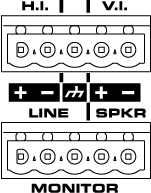Analog Out – DCIO/DCIO-H
The Analog Output provides line-level output for devices requiring line-level analog input. The Analog Output is physically a part of the DCIO and DCIO-H. The Analog Output converts the processed digital signal to analog and provides software controls before and after the convertor. Connections are made using two five-position Euro-style connectors.
Tip: For additional properties not listed, refer to the Properties Panel help topic for more information.
The controls listed below are available on the Analog Output component in Q-SYS Designer. Each control listed in the Analog and Digital sections, are one per channel.
Rear Panel Connector

Channel
HI
Line output channel for hearing impaired.
VI
Line Output for visually impaired.
Line
Balanced line-level output at 14dBu.
Spkr (Speaker)
Powered output, 10 watts maximum, for a monitor loudspeaker.
Analog
Peak Output Level (dBu)
Measures Peak Output level to the output device for channels HI, VI, and Line.
The Spkr output level is measured in Volts
Relay Mute
Mutes the output after the D-A converter and before the output. One button mutes all channels.
Max RMS Output Level (dBu)
Controls the analog RMS output level after the D/A converter. This level is typically set slightly lower than the destination's sensitivity or maximum input level in order to avoid clipping the signal of a power amplifier. Varies in direct proportion with Output Gain. Not applicable for the Spkr channel.
Output Gain (dB)
The amount of gain applied to the outgoing analog signal. Varies in direct proportion with the Max RMS Output Level.
Not applicable for the Spkr channel.
Digital
Peak Output Level (dBFS)
Measures the Digital Signal level prior to the D/A converter.
Clip
Red LED indicating if the signal is being clipped.
- Green = good
- Yellow = close to clipping
- Red = clipping
Clip Hold
When engaged, this holds the clip indication until manually cleared.
Invert
Inverts the audio signal.
Mute
Mutes the digital audio signal.
Gain
Controls the gain of the digital audio signal prior to the D / A converter. Range is -100 to +20.
Status
Component status is conveyed with the Status LED and Status box, which uses both color and text to indicate the current condition:
- OK: The device is functioning normally.
- Initializing: The device is in the process of a firmware, patch, or configuration update, or the design is starting.
- Compromised: The device is functioning, but a non-fatal problem exists. Refer to the Status box for details.
- Missing: The device cannot be discovered.
- Fault: The device is malfunctioning or is not properly configured. Refer to the Status box for details.
- Unknown: This status appears during a Core reboot (for example, during a firmware update), or when a design is being uploaded to the Core and before it has started running.
- Not Present: If applicable to the device, this status appears when the device is not connected to the network and its Is Required component property is set to 'No'. This status also appears if the device component's Dynamically Paired property is set to 'Yes', pairing has not been assigned in Core Manager, and the device component's Is Required property is set to 'Yes'. See Dynamic Pairing.
Amp (Spkr) Channel
The following Control Pin parameters are specific to the Amp (Spkr), Channel.
|
Pin Name |
Value |
String |
Position |
Pins Available |
|---|---|---|---|---|
|
Gain |
-100 to 20 |
-100dB to 20dB |
0 to 1.00 |
Input / Output |
|
Level (dBFS) |
-120 to 20 |
-120dB to 20dB |
0 to 1.00 |
Output |
|
Analog Level |
0 to 80 |
0V to 80V |
0 to 1.00 |
Output |
HI and VI Channels
The following Control Pin parameters are specific to the HI and VI Channels.
|
Pin Name |
Value |
String |
Position |
Pins Available |
|---|---|---|---|---|
|
Gain |
-100 to 20 |
-100dB to 20dB |
0 to 1.00 |
Input / Output |
|
Level (dBFS) |
-120 to 20 |
-120dB to 20dB |
0 to 1.00 |
Output |
|
Level (dBu) |
-120 to 24 |
-120dB to 24dB |
0 to 1.00 |
Output |
|
Max RMS Output Level (dBu) |
-42 to 18 |
-42.0dBu to +18dBu |
0 to 1.00 |
Output |
|
Output Gain |
-60 to 0 |
-60dB to 0dB |
0 to 1.00 |
Input / Output |
Line Channel
The following Control Pin parameters are specific to the Line Channel.
|
Pin Name |
Value |
String |
Position |
Pins Available |
|---|---|---|---|---|
|
Gain |
-100 to 20 |
-100dB to 20dB |
0 to 1.00 |
Input / Output |
|
Level (dBFS) |
-120 to 20 |
-120dB to 20dB |
0 to 1.00 |
Output |
|
Analog Level |
-120 to 24 |
-120dB to 24dB |
0 to 1.00 |
Output |
|
Max Level |
-46 to 14 |
-46.0dBu to +14dBu |
0 to 1.00 |
Output |
|
Output Gain |
-60 to 0 |
-60dB to 0dB |
0 to 1.00 |
Input / Output |
Common
The following Control Pins are common to all four channels.
|
Pin Name |
Value |
String |
Position |
Pins Available |
|---|---|---|---|---|
|
Clip (LED) |
0 1 |
false true |
0 1 |
Output |
|
Clip Hold |
0 1 |
false true |
0 1 |
Input / Output |
|
Invert |
0 1 |
normal invert |
0 1 |
Input / Output |
|
Mute |
0 1 |
unmute mute |
0 1 |
Input / Output |
|
Relay Mute |
0 1 |
unmute mute |
0 1 |
Input / Output |
|
Status |
0 1 2 3 4 |
OK (green) Compromised (orange) Fault (red) Unknown (red) Updating (blue) |
0 0.250 0.500 0.750 1.00 |
Output |
